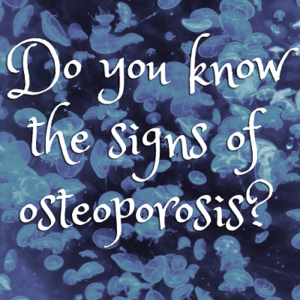 There are many factors which can contribute to osteoporosis, and the condition may be well advanced before obvious signs and symptoms are visible. A person leading a relatively sedentary or non-physical lifestyle may not be aware of their bone loss and may put down any noticeable physical differences down to just getting older.
There are many factors which can contribute to osteoporosis, and the condition may be well advanced before obvious signs and symptoms are visible. A person leading a relatively sedentary or non-physical lifestyle may not be aware of their bone loss and may put down any noticeable physical differences down to just getting older.
There are a few signs and symptoms to be on the lookout for, including the following:
Bone Breakage or Fractures
The most obvious symptom (and how many find out they have developed osteoporosis) is too often from the result of a bone breakage. This can be in areas and joints that carry a major share of the load such as the hip, spine or wrist. These fractures may occur though seemingly minor actions such as stepping off a curb or lifting something too heavy.
The person may experience pain and wonder why! When x-rays are taken to diagnose the pain, a bone fracture is often found and the level of bone density loss is apparent to the doctor.
Curvature of the Spine
Another obvious sign of osteoporosis is a marked curvature of the spine. Loss of skeletal strength results in a less than ideal posture.
Additionally, an injury to multiple vertebra of the spine can compress the vertebra together also resulting in a pronounced curvature of the spine.
The curving of the upper back was once known as a dowager’s hump. Dowager means an elderly woman or widow. This is because, although anyone can be affected by osteoporosis, most sufferers were and are women, particularly older women.
Loss of Height
A loss of height occurs together with a stooped posture. This may be due to compression fractures in the spine, as well as the reduction of the vertebra mass and the shrinking of the gel-filled disks between them.
Joint Pain
Sometimes osteoporosis contributes to joint pain and swelling that is easily confused with arthritis. Due to personal misdiagnosis, many osteoporosis cases get worse before medical help is sought. Pain and swelling of the joints should be brought to a doctor’s attention to determine the cause and appropriate remedial action and treatment.
Dental Problems
Research has shown that many people suffering with teeth loss and periodontal disease are also diagnosed with osteoporosis. The studies showed that people who had osteoporosis were at a much higher risk of having periodontal disease.
There is a higher incidence of both periodontal disease and osteoporosis in post-menopausal women, compared to other demographics.
Other Contributing Risk Factors
Apart from the age aspect, some people may be more prone to developing osteoporosis due to other risk factors. Some risk factors that could contribute to developing osteoporosis are:
- Constitution – the build of the body is a factor in developing osteoporosis; those that are thinner or more slightly built are more prone to this condition.
- Gender – osteoporosis affects many more women than men, and to a larger degree.
- Physical Activity – people who are physically active are less likely to develop osteoporosis than those who are inactive.
- Genetics – studies show that children who have parents with osteoporosis are more likely to develop osteoporosis as they age.
Osteoporosis can occur and develop even while noticeable symptoms are absent.
Often we tend to take for granted such symptoms or mistake them for something else. This gives more time for the condition to go undiagnosed and for the bones to deteriorate further.
Prevention is better than cure, so start eating a bone healthy diet and exercise regularly out in the sun!






